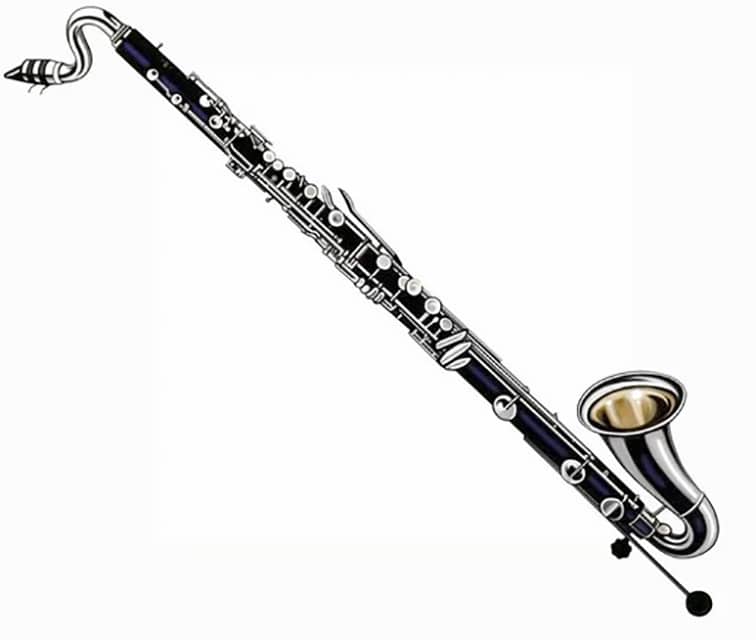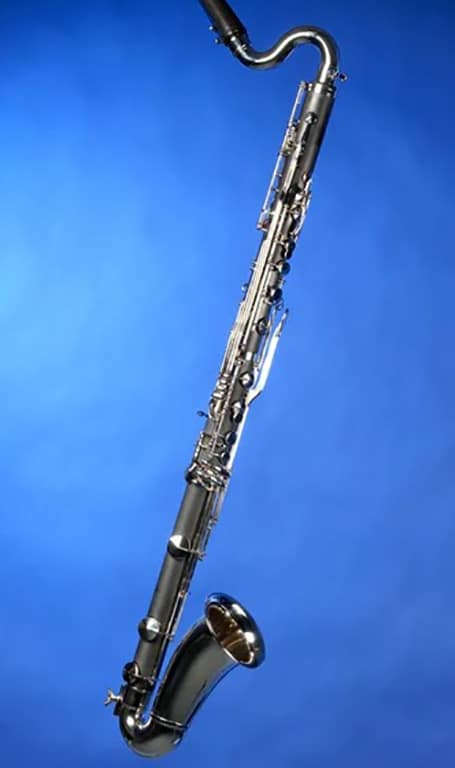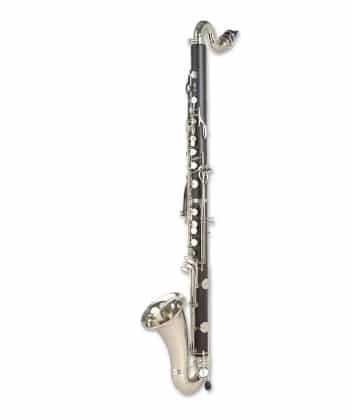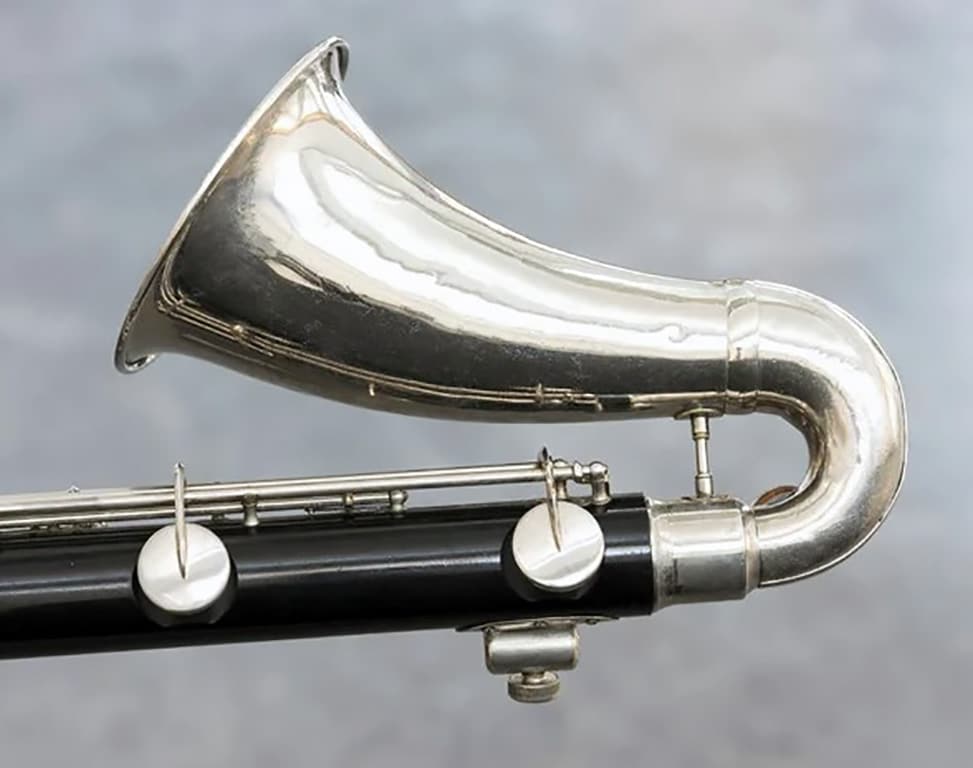Best Clarinet
Brand
-
Overall: Classic materials with silver-plated nickel silver keys and neck
-
Best Feature: Enjoy a long-lasting instrument with inline trill keys and leather pads
-
TedScore™: 8/10
Best Student
Clarinet
-
Overall: Affordable price point with a Low C to high Eb range
-
Best Feature: Has ABS body with a matte finish and comes with adjustable thumb rest
-
TedScore™: 7/10
Best Professional
Clarinet
AUTHENTIC TONE
-
Overall: ABS resin body provides tone very similar to that of professional wood models
-
Best Feature: The 19-key Boehm system is optimally set-up
-
TedScore™: 9/10
Curious about a special musical instrument that brings depth and richness to orchestral music?
We’re bringing you the bass clarinet.
This instrument is a member of the clarinet family and produces a deep, resonant sound distinct from other woodwind instruments.
Keep reading to learn more about this amazing instrument!
What is a Bass Clarinet?
You might have heard of the bass clarinet if you’re a music enthusiast.
But what is it exactly?
Let’s explore this unique musical instrument’s history and physical characteristics.
The bass clarinet is a larger version of the clarinet, and it’s typically pitched in B♭. However, it can also be found in other keys, such as C and A.
The instrument is made of wood, plastic, or both. It has a curved metal neck and a long, straight body with a flared bell at the end.

The bass clarinet has a range that extends from the low E♭ to the high C. It can produce a rich, warm tone that blends well with other instruments in an ensemble. The instrument is played with a single reed attached to the mouthpiece.
One of the most notable physical characteristics of the bass clarinet is its size. It’s much larger than the soprano clarinet, making it challenging to transport and play. However, its size also contributes to its unique sound and versatility.
How to Play the Bass Clarinet
Breathing and Posture
Before you start playing the bass clarinet, it is important to establish proper breathing and posture. Here are some tips to help you get started:
Sit up straight with your feet flat on the floor.
Hold the bass clarinet with your left hand, and use your right hand to operate the keys.
Take deep breaths from your diaphragm, and exhale slowly through the mouthpiece.
Keep your shoulders relaxed and your neck straight.
Fingering
The bass clarinet has a complex fingering system that can take some time to master. Here are some tips to help you get started:
Memorize the fingerings for each note, and practice them until they become second nature.
Use the correct fingerings for each note to ensure accurate intonation.
Keep your fingers close to the keys to minimize movement and improve speed.

Technique
To play the bass clarinet effectively, you need to develop good technique. Here are some tips to help you improve your technique:
Practice long tones to develop breath control and tone quality.
Use a metronome to improve your timing and rhythm.
Experiment with different articulations, such as staccato and legato, to add variety to your playing.
Buying a Bass Clarinet
Types of Bass Clarinets

There are two main types of bass clarinets:
the standard bass clarinet and the low C bass clarinet.
The standard bass clarinet typically has a range that goes down to a written E flat, while the low C bass clarinet extends to a written C.
Professional players typically prefer the low C bass clarinet, as it allows for a wider range of notes and greater flexibility in playing.
However, it’s also more expensive than the standard bass clarinet.
Brands and Prices
When it comes to brands, a few stand out in the world of bass clarinets. Buffet Crampon and Selmer Paris are the most popular brands known for their high-quality instruments. Other brands to consider include Yamaha, Leblanc, and Jupiter.
Prices for bass clarinets can vary widely depending on the brand and type of instrument.
Student bass clarinets can start as low as £1,500, while higher-quality models can cost anywhere from £2,000 to £7,000. Professional-grade bass clarinets can run anywhere from £10,000 to £15,000 or more.
When shopping for a bass clarinet, it’s important to consider your needs and budget. A student model may be the best choice if you’re starting out.
However, a high-end model may be worth the investment if you’re a professional player looking for the best possible sound and range.


Recommended Bass Clarinetst
Rosedale Bass Clarinet by Gear4music

FEATURES:-With a Low C to high Eb range
-Has ABS body with a matte finish
-Comes with adjustable thumb rest
- Affordable price point
- Includes a hard case for transportation and storage
- May require adjustments before use
When you click ‘Check Price’, you’ll see there are loads of great places to buy this item. Our personal favorite is Sweetwater for the US, and Thomann and Gear4Music for the UK & Europe.
They are the largest music retailers, with excellent customer service, competitive prices, really fast shipping, and the longest guarantees.
The professional musician who wrote this article combined many things,
from the product build, manufacturer’s reputation through to feedback
from other users, to create our famous TedScore™.
Jupiter JBC1000

FEATURES: Classic materials with silver-plated nickel silver keys and neck
-Enjoy a long-lasting instrument with inline trill keys and leather pads
- Capable of rich, refined tones with added durability
- Includes a wood-frame case so you can travel right away
- Text
- Maybe a bit heavier than some other bass clarinets on the market
When you click ‘Check Price’, you’ll see there are loads of great places to buy this item. Our personal favorite is Sweetwater for the US, and Thomann and Gear4Music for the UK & Europe.
They are the largest music retailers, with excellent customer service, competitive prices, really fast shipping, and the longest guarantees.
The professional musician who wrote this article combined many things,
from the product build, manufacturer’s reputation through to feedback
from other users, to create our famous TedScore™.
Yamaha YCL221II

FEATURES: -ABS resin body provides tone very similar to that of professional wood models
-With high-quality nickel-plated bell provides excellent projection and stability
-The 19-key Boehm system is optimally set-up to allow for rapid, fluid responsiveness
- Affordable bass clarinet option from Yamaha
- Comes included with a premium Yamaha carry case
- Register for a 5-year extended warranty and 3-month Tomplay Premium
- May not have the same level of tonal depth and richness as some higher-end bass clarinets
When you click ‘Check Price’, you’ll see there are loads of great places to buy this item. Our personal favorite is Sweetwater for the US, and Thomann and Gear4Music for the UK & Europe.
They are the largest music retailers, with excellent customer service, competitive prices, really fast shipping, and the longest guarantees.
The professional musician who wrote this article combined many things,
from the product build, manufacturer’s reputation through to feedback
from other users, to create our famous TedScore™.
Maintaining Your Bass Clarinet
Cleaning and Care
Taking care of your bass clarinet is essential to ensure it remains in top condition and produces the best sound possible.
Proper care and maintenance also help to prolong the lifespan of your instrument. Here are some tips on how to take care of your bass clarinet:
Use a cleaning swab to remove all moisture inside the body. For a bass clarinet, use a large cleaning swab. Make sure the swab catches on nothing and pull it through slowly without forcing it.
Regularly use a soft cloth to polish your bass clarinet. This helps to keep the plating healthy and prevents tarnishing.
Keep your bass clarinet safe and dry. Avoid exposing it to direct sunlight or extreme temperatures.
Troubleshooting
Taking care of your bass clarinet is essential to ensure it remains in top condition and produces the best sound possible.
Proper care and maintenance also help to prolong the lifespan of your instrument. Here are some tips on how to take care of your bass clarinet:
If your keys become sticky, use a key oil to lubricate them. Avoid using too much oil, as this can cause other problems.
If you notice any loose screws, tighten them carefully with a screwdriver. Avoid overtightening, as this can damage the screws or the instrument.
If your reed becomes damaged or warped, replace it with a new one. Always have a spare reed on hand in case of emergencies.
Bass Clarinet
Key Takeaways
The bass clarinet is a unique and fascinating instrument that adds depth and richness to any musical ensemble. Whether you’re a seasoned professional or a beginner just starting out, the bass clarinet offers a world of possibilities for musical expression.
And if you’re looking for a challenge, the bass clarinet will keep you on your toes with its demanding technical requirements.
So why not give it a try?
You might discover your new favorite instrument and become the next great bass clarinet virtuoso!
Wait, there’s more!!!
Ready to learn more and take your clarinet playing to the next level? Check out these top brands for the best sound and performance!
Clarinet Best Brands
FAQ's
The bass clarinet is generally considered more challenging to play than the clarinet due to its larger size and lower range. It requires more breath support, stronger embouchure, and greater physical endurance.
The bass clarinet is not as commonly played as the standard clarinet, but it is not necessarily a rare instrument. It is frequently used in orchestral and band music, and many clarinet players also learn to play the bass clarinet.
Bass clarinets can be expensive, with professional-level instruments often costing several thousand dollars. However, student and intermediate models are also available at more affordable prices.











love the part about maintaining your bass clarinet, it’s super important but easy to forget. great tips there!
I’ve been playing the bass clarinet for over a decade, and the section on technique resonates with me deeply. It’s crucial to emphasize the importance of technique from the beginning to prevent the formation of bad habits. However, I believe some additional pointers on breath control could enhance this section even further, offering beginners a more comprehensive guide. Overall, though, a great introduction by
Kymia Kermani.
bass clarinets sound so cool, wish i could play one haha
hey, i’m thinking of picking up the bass clarinet for school band. is it much harder than the regular clarinet? got a bit worried about the fingering part mentioned by Kymia Kermani. any tips for beginners?
The transition isn’t too tough! Focus on getting comfortable with the larger size and weight, and the rest will follow. Good luck!